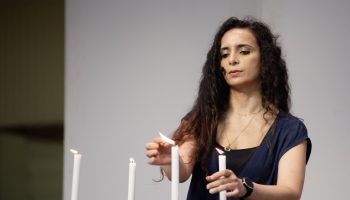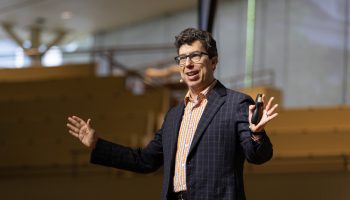
Entropy, in physics, is essentially a measure of the amount of disorder in a physical system — this means that if a system has a low number of rearrangements, it has low entropy, and if it has a high number of rearrangements, it has high entropy. Brian Greene, one of the foremost theoretical physicists in the world, compared entropy to a messy desk with papers and pens randomly scattered about.
“When the desk is messy, it has high entropy, high disorder, because there are many rearrangements that you would completely not notice if someone were to do them behind your back,” Greene said. “But if you have a very orderly, very clean desk, … if you go over to that desktop and start to rearrange the ingredients, you do notice.”
Another example of high entropy is how sand on a beach can be configured into almost countless variations. A sand castle, however, has low entropy because it is highly organized and changing any part will make the whole castle look different.
Greene said that the entropy of one system can affect others, such as with stars, and systems effectively release disorder into their surroundings and keep order within themselves. He said that steam engines of the 17th and 18th centuries burnt “orderly” fuel and released some of that heat into the environment.
“The steam engine must expel the entropy to the environment in order to maintain its orderly form. How does it expel that entropy?” Greene said. “It emits heat to the surroundings, allowing it to maintain its order. While the environment soaks up the disorder, it soaks up in toxic waste.”
At 10:45 a.m. EDT Monday, Aug. 10, 2020, on the CHQ Assembly Video Platform, Greene delivered a lecture titled “Mind, Matter and Our Search for Meaning in an Evolving Universe,” opening Week Seven of the Chautauqua Lecture Series, themed “The Science of Us.” Greene discussed how the universe was created through both a process toward greater order and complex structures such as living creatures, as well as progressing to more disorderly systems.
Greene also discussed evolution. He said some scientists tend to view evolution and entropy as “embattled characters fighting it out for dominance.” Evolution is viewed as building evermore complex structures, while entropy is seen as causing more and more disorder.
“But that is too simplistic a description,” Greene said. “There’s a lot of truth to it, but it’s not the full story.”
While many people associate evolution with living organisms and parents passing down their genes, evolution occurs even down to the level of an atom.
“Over time, interesting, complex, molecular configurations can naturally emerge. No guiding intelligence necessary, just the laws of physics acting themselves out on the ingredients,” Greene said. “The ingredients have this capacity to make copies of themselves and every replication process has some degree of imperfection.”
These imperfections, or modifications to the molecules, Greene said, eventually created systems better suited to their environment.
“Over time,” Greene said, “we get the kinds of molecules able to carry out processes that look like they require some kind of guiding intelligence.”
Greene then talked about the fate of different astrological bodies, such as the sun and black holes. He said in 5 billion years, the sun will use up all of its fuel in its core, imploding inward and rising in temperature. Greene said the sun’s “hydrogen will burn with such intensity that it will force the sun to swell outwards” and become 150-200 times its size, swallowing up the planets Mercury and Venus.
Black holes, which are regions of space where the gravitational pull is so strong that anything that falls in cannot escape, were thought to be stable and orderly for a long time, he said, as scientists thought black holes could only get bigger. Greene said physicist Stephen Hawking showed in the 1970s that light, which is a form of energy, “streams outward from the edge of a black hole. It’s sort of like burning a piece of charcoal.”
“When you take energy away from the black hole itself, it shrinks. It gets smaller and smaller. We do not yet know what happens at the very end of a black hole when it shrinks all the way down to nothingness,” Greene said. “All that will be left in the cosmos are these particles … wafting through the darkness.”
When some people hear Greene talking about how the universe and its origins can be broken down into equations which have “no evidence of anything like meaning or value or purpose,” they often think he is unfairly criticizing everything they hold dear.
Greene said he is doing the opposite. “Against all odds,” he said, “we are so spectacularly ordered.”
“We can experience wondering. I’m thinking about everything from building the pyramids to Beethoven’s Ninth Symphony to the Mona Lisa to King Lear to quantum mechanics and the general theory of relativity,” Greene said. “The very fact that collections of particles can do all that fills me with a deep sense of gratitude that really verges upon reverence.”
The lecture then shifted to a Q-and-A session with Chautauqua Institution Vice President and Emily and Richard Smucker Chair for Education Matt Ewalt. Ewalt asked Greene what he thought about the concept of a multiverse.
He said the idea of a multiverse is worthwhile in “our metaphorical toolkit,” something for people to turn to if scientists cannot find any other answers. Greene gave the example of scientists being able to measure the amount of dark energy in space, but unable to explain why that amount exists. Some people say that the value of dark energy changes from universe to universe.
“The idea that we are one universe of many is highly speculative,” Greene said. “By no means do we have any evidence for it, but it is an idea that’s worthwhile to have at our disposal.”
Ewalt then asked about the emerging narrative in society of distrust in scientists and the need for teaching science, especially during the COVID-19 pandemic.
“I don’t sense the mistrust for science surrounding COVID-19. As I sense the growing distrust of the way our leaders have responded to the scientific insights surrounding COVID-19, we see a dance playing out in the world in real time that juxtaposes economic viability with personal safety,” Greene said.
Every challenge people face has science at its core, and scientists need to play a bigger role in government.
“If you don’t have leaders that really understand and respect the science, we are going to make wrong decisions left and right going forward,” Greene said. “This is one test case, and it’s a vital one, but it’s a much larger issue of the role that scientific insight will play in the decision-making process going forward.”




